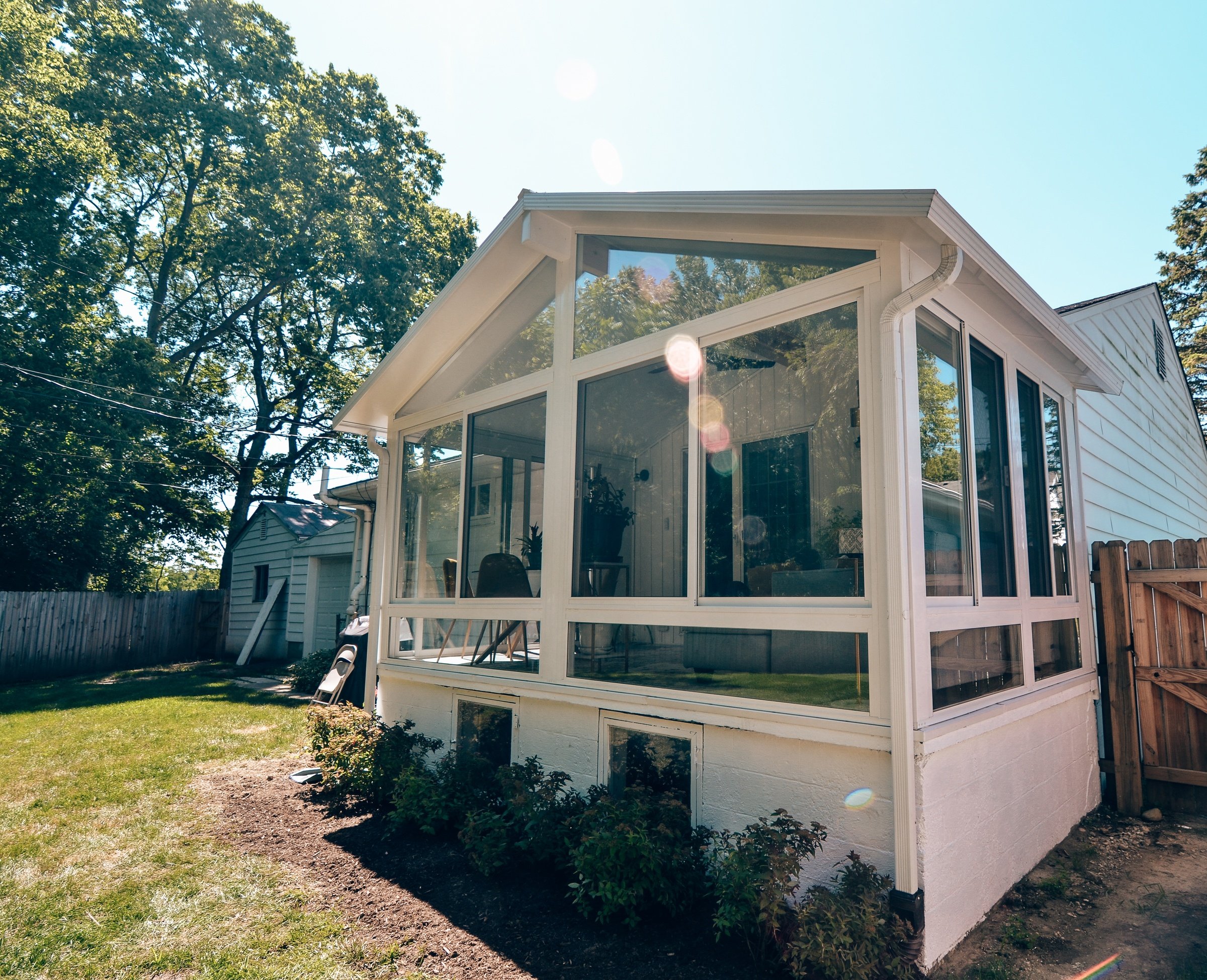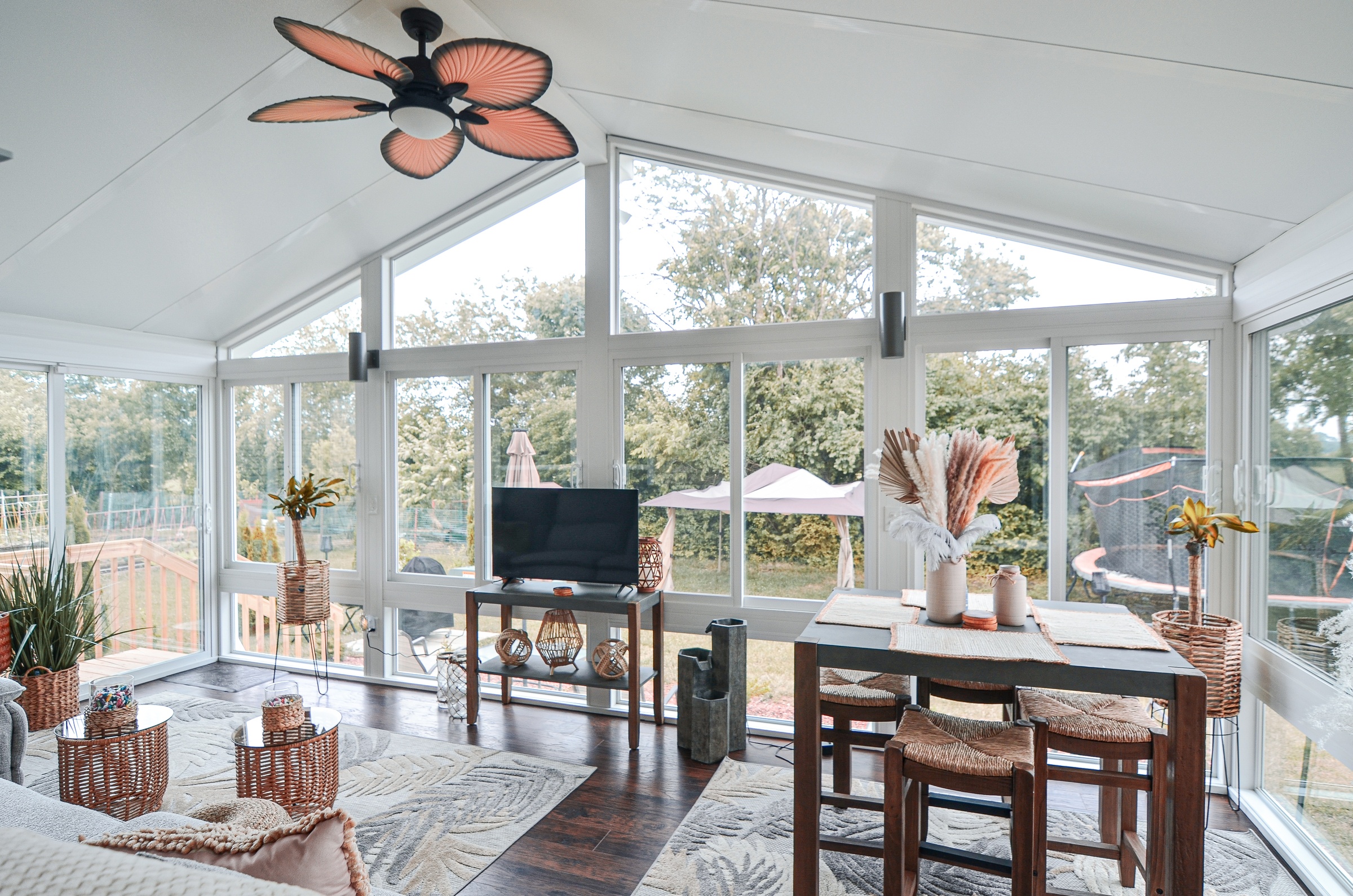Are Sunrooms Considered Living Space?
February 16th, 2024 | 6 min read


Discover whether sunrooms are considered living spaces in this informative article.
Are Sunrooms Considered Living Space?
A sunroom is a unique addition to any home, providing a space to enjoy the outdoors while being protected from the elements. However, homeowners often ask whether a sunroom can be considered a living area. This article will delve into the sunroom concept and explore the factors that determine its classification as a living space. We will also discuss the legal considerations, benefits, and potential drawbacks of using a sunroom as a living space.
Understanding the Concept of a Sunroom
A sunroom is primarily made up of vinyl or aluminum walls that can be filled with windows. It is designed to be an extension of the home, providing a space where homeowners can enjoy natural light and the surrounding landscape. Sunrooms are typically used for relaxation, dining, or even as a space for indoor gardening.
Imagine waking up on a beautiful sunny morning, stepping into your sunroom, and being greeted by the warm rays of sunlight streaming through the expansive glass walls. The gentle breeze whispers through the room, carrying the scents of blooming flowers from your garden. You settle into a comfortable chair, sipping a cup of freshly brewed coffee, and immerse yourself in the serene beauty of nature.
As the day progresses, the sunroom transforms into a versatile space that adapts to your needs. It becomes the perfect spot to host an intimate dinner party, with the soft glow of the setting sun casting a warm ambiance. The glass walls allow you to dine under the stars, surrounded by the enchanting sounds of nature.
Standard Features of a Sunroom
Sunrooms often feature insulated flooring, electrical outlets, and sometimes even plumbing for convenience. The electrical outlets in the sunroom provide the convenience of charging your devices or plugging in a cozy electric fireplace, creating a relaxing atmosphere on chilly evenings. Some sunrooms may have screens or shades to control the amount of sunlight entering the space. The design and features of a sunroom can vary depending on the homeowner’s preferences and the home’s overall architectural style.
Furthermore, the addition of screens or shades allows you to control the amount of natural light streaming into the room. You can adjust them to create the perfect balance between sunlight and shade, ensuring a comfortable environment no matter the time of day.
Legal Considerations for Sunrooms as Living Spaces
Before converting a sunroom into a living space, homeowners should be aware of the legal considerations and regulations that may apply.
Expanding your sunroom into a fully functional living space can be an exciting project, but it’s important to navigate the legal aspects and regulations that come with it. Understanding your location’s building codes and permit requirements ensures a smooth and hassle-free conversion process.
Building Codes and Regulations
Building codes and regulations vary by location, and it is important to understand the requirements before converting a sunroom into a living space. These codes are in place to ensure your home’s safety and structural integrity.
When converting a sunroom into a living space, you may need to consider factors such as electrical wiring, insulation, ventilation, and fire safety. Building codes outline the specific standards that must be met for each element, ensuring that your new living space complies with the law.
It’s also worth noting that building codes can change over time, so what may have been compliant when the sunroom was initially constructed may no longer meet the current standards. Therefore, consulting with local authorities or a licensed contractor is essential to ensure that your sunroom conversion meets all the necessary codes and regulations.
Permit Requirements For Sunrooms
Permit requirements for sunrooms can vary depending on size, location, and intended use. It’s crucial to familiarize yourself with the specific permit requirements in your area to avoid any legal complications.
Sometimes, you may need a building permit before starting the conversion process. This permit typically involves submitting detailed plans and specifications of the proposed changes to the local building department for review. This review ensures that the conversion meets all safety and zoning requirements.
Additionally, inspections may be required at various stages of the conversion process. Qualified professionals conduct these inspections to verify that the work follows the approved plans and applicable building codes.
Remember that permit requirements and inspection procedures can vary significantly from one jurisdiction to another. Therefore, consulting with your local building department or a licensed contractor familiar with your area’s regulations is essential.
Understanding and complying with the building codes and permit requirements allows you to enjoy your newly converted sunroom as a safe and legally compliant living space.
Factors Determining if a Sunroom is a Living Space
Several factors come into play when determining whether a sunroom can be considered a living space. Let’s explore some of these factors:
Heating and Cooling Systems
To be considered a living space, a sunroom should have a heating and cooling system to maintain a comfortable temperature year-round. This is especially important in regions with extreme weather conditions.
When it comes to heating, sunrooms often rely on various options, such as radiant floor heating, electric baseboard heaters, or even ductless mini-split systems. These systems ensure that the temperature in the sunroom remains cozy during the colder months, allowing you to enjoy the space regardless of the weather outside.
For cooling, sunrooms often utilize air conditioning units or ceiling fans to keep the space cool during hot summer days. The sunroom can become a comfortable retreat even on scorching afternoons with proper insulation and ventilation.
Insulation and Weatherproofing
A sunroom must be appropriately insulated and weatherproofed to be classified as a living space. This includes insulation in walls, roofs, and flooring to ensure energy efficiency and protection from the elements.
Regarding insulation, sunrooms often feature double-pane windows with low-emissivity coatings to minimize heat transfer. This helps to keep the sunroom warm in winter and cool in summer, reducing the reliance on heating and cooling systems.
In addition to insulation, weatherproofing is essential to prevent leaks and drafts. Sunrooms often have weatherstrips around the windows and doors to properly seal joints and seams. This ensures the sunroom remains dry and comfortable even during heavy rain or strong winds.
Accessibility and Safety Measures
To be considered a living space, a sunroom should be easily accessible from the home’s main living areas. It should also meet safety regulations, including proper electrical wiring, adequate fire exits, and compliance with local building codes.
Regarding accessibility, sunrooms are often designed with wide doorways and ramps to accommodate individuals with mobility challenges. This ensures that the sunroom can be enjoyed by everyone in the household, regardless of their physical abilities.
Regarding safety measures, sunrooms are equipped with smoke detectors, fire extinguishers, and proper electrical wiring to minimize the risk of fire hazards. Additionally, the sunroom should have accessible fire exits, such as doors or windows that can be easily opened inside, providing a safe escape route in emergencies.
Compliance with local building codes is crucial to ensure that the sunroom meets all structural integrity and safety requirements. This includes considerations for load-bearing capacity, electrical standards, and other regulations set by the local authorities.
Benefits of Considering a Sunroom as a Living Space
There are several benefits to considering a sunroom as a living space.
Adding a sunroom can be a game-changer when it comes to home improvements. Not only does it bring a touch of elegance and uniqueness to your home, but it also offers many advantages that make it a worthwhile investment.
Increased Home Value
One of the most significant benefits of adding a sunroom is the potential increase in home value. When potential buyers walk into a house with a sunroom, they are often captivated by the additional living space and the unique aesthetic it provides. The sunroom becomes a selling point, setting your home apart from others in the market. So, not only will you get to enjoy the sunroom while you live in the house, but you will also reap the financial rewards when it comes time to sell.
Imagine potential buyers walking through your home, envisioning themselves basking in the natural light, surrounded by lush greenery, and feeling a sense of tranquility. The sunroom becomes an oasis that adds value to their everyday life. It becomes a place where they can start their day with a cup of coffee, savor the beauty of nature, and unwind after a long day. This allure makes a sunroom a wise investment for homeowners looking to sell their property in the future.
Additional Space for Relaxation or Entertainment
A sunroom offers more than just an increase in home value; it provides a versatile space for relaxation and entertainment. Imagine having a tranquil haven right in your home, where you can escape daily hustle and bustle. The sunroom becomes your retreat, where you can unwind, read a book, or soak up the sun’s warmth.
Furthermore, a sunroom serves as an excellent area for entertaining guests. You can host gatherings and social events while enjoying the beauty of the outdoors without being exposed to harsh weather conditions. Whether a cozy dinner party or a lively game night, the sunroom becomes a versatile space that seamlessly blends indoor comfort with outdoor charm.
Picture yourself surrounded by friends and family, laughter filling the air as you enjoy a delicious meal together. The sunroom becomes the heart of your home, a space that brings people together and creates lasting memories.
Potential Drawbacks of Sunrooms as Living Spaces
While there are many benefits to using a sunroom as a living space, homeowners should consider some potential drawbacks.
Cost of Conversion and Maintenance
Converting a sunroom into a living space can be a significant investment. Homeowners need to consider the costs associated with insulation, heating and cooling systems, and any necessary structural modifications. Additionally, ongoing maintenance, such as cleaning the glass and ensuring the integrity of the sunroom, should also be factored in.
Potential Issues with Privacy
As sunrooms primarily have wall-to-wall windows, privacy can be a concern. Homeowners should explore options such as installing blinds or shades to address this issue. Additionally, the location of the sunroom within the property should be carefully considered to ensure maximum privacy.
In conclusion, while sunrooms can provide a beautiful and versatile space, whether they can be considered living space depends on factors such as heating and cooling systems, insulation, accessibility, and compliance with local regulations. Considering the legal considerations, benefits, and drawbacks discussed in this article, homeowners can make informed decisions about converting sunrooms into living spaces.
JSB Home Solutions was founded by my dad. Growing up around the family business means that I've been living and breathing home remodeling for quite literally my entire life. When I'm not at work, you can find me homeschooling my three kids, in the garden, or cheering my kids on at wrestling tournaments.
Topics:
.png?width=1037&height=397&name=JSB%20Logo%20with%20Services%20(1).png)
.png?width=1047&height=396&name=JSB%20Logo%20with%20Services%20(2).png)

